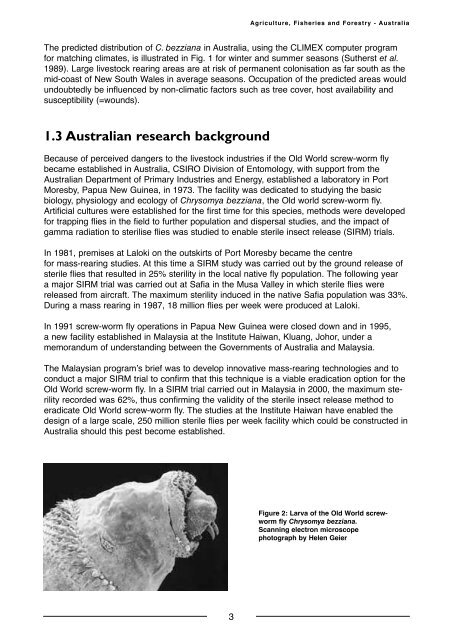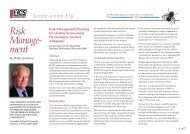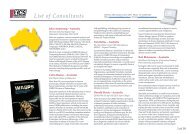Manual for Diagnosis of Screw-worm Fly - xcs consulting
Manual for Diagnosis of Screw-worm Fly - xcs consulting
Manual for Diagnosis of Screw-worm Fly - xcs consulting
Create successful ePaper yourself
Turn your PDF publications into a flip-book with our unique Google optimized e-Paper software.
The predicted distribution <strong>of</strong> C. bezziana in Australia, using the CLIMEX computer program<br />
<strong>for</strong> matching climates, is illustrated in Fig. 1 <strong>for</strong> winter and summer seasons (Sutherst et al.<br />
1989). Large livestock rearing areas are at risk <strong>of</strong> permanent colonisation as far south as the<br />
mid-coast <strong>of</strong> New South Wales in average seasons. Occupation <strong>of</strong> the predicted areas would<br />
undoubtedly be influenced by non-climatic factors such as tree cover, host availability and<br />
susceptibility (=wounds).<br />
1.3 Australian research background<br />
Agriculture, Fisheries and Forestry - Australia<br />
Because <strong>of</strong> perceived dangers to the livestock industries if the Old World screw-<strong>worm</strong> fly<br />
became established in Australia, CSIRO Division <strong>of</strong> Entomology, with support from the<br />
Australian Department <strong>of</strong> Primary Industries and Energy, established a laboratory in Port<br />
Moresby, Papua New Guinea, in 1973. The facility was dedicated to studying the basic<br />
biology, physiology and ecology <strong>of</strong> Chrysomya bezziana, the Old world screw-<strong>worm</strong> fly.<br />
Artificial cultures were established <strong>for</strong> the first time <strong>for</strong> this species, methods were developed<br />
<strong>for</strong> trapping flies in the field to further population and dispersal studies, and the impact <strong>of</strong><br />
gamma radiation to sterilise flies was studied to enable sterile insect release (SIRM) trials.<br />
In 1981, premises at Laloki on the outskirts <strong>of</strong> Port Moresby became the centre<br />
<strong>for</strong> mass-rearing studies. At this time a SIRM study was carried out by the ground release <strong>of</strong><br />
sterile flies that resulted in 25% sterility in the local native fly population. The following year<br />
a major SIRM trial was carried out at Safia in the Musa Valley in which sterile flies were<br />
released from aircraft. The maximum sterility induced in the native Safia population was 33%.<br />
During a mass rearing in 1987, 18 million flies per week were produced at Laloki.<br />
In 1991 screw-<strong>worm</strong> fly operations in Papua New Guinea were closed down and in 1995,<br />
a new facility established in Malaysia at the Institute Haiwan, Kluang, Johor, under a<br />
memorandum <strong>of</strong> understanding between the Governments <strong>of</strong> Australia and Malaysia.<br />
The Malaysian program’s brief was to develop innovative mass-rearing technologies and to<br />
conduct a major SIRM trial to confirm that this technique is a viable eradication option <strong>for</strong> the<br />
Old World screw-<strong>worm</strong> fly. In a SIRM trial carried out in Malaysia in 2000, the maximum sterility<br />
recorded was 62%, thus confirming the validity <strong>of</strong> the sterile insect release method to<br />
eradicate Old World screw-<strong>worm</strong> fly. The studies at the Institute Haiwan have enabled the<br />
design <strong>of</strong> a large scale, 250 million sterile flies per week facility which could be constructed in<br />
Australia should this pest become established.<br />
3<br />
Figure 2: Larva <strong>of</strong> the Old World screw<strong>worm</strong><br />
fly Chrysomya bezziana.<br />
Scanning electron microscope<br />
photograph by Helen Geier




